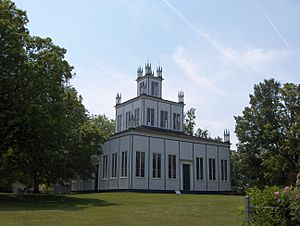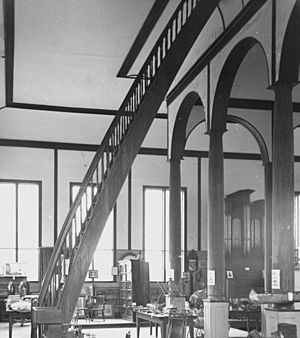Sharon Temple facts for kids
The Sharon Temple is a special outdoor museum located in the village of Sharon, Ontario. It was recognized as a National Historic Site of Canada in 1990. The site has eight old buildings and homes, and it holds about 6,000 historical items. The Sharon Temple Museum Society now owns and takes care of the site. They make the building available for public events like tours, concerts, weddings, and other special occasions.
The temple was built between 1825 and 1832 by a group called The Children of Peace. Their leader was David Willson, who was once a Quaker. The temple was built on his land. Other buildings on the site have also been fixed up. These include David Willson's Study, which is a smaller building. The Ebenezer Doan house, built in 1819 by the temple's main builder, was moved from a nearby farm and restored with an old-fashioned garden. You can also see the "cook house" where people made and ate meals together. There's also a "drive shed" with old carriages and a unique round outhouse designed by David Willson. The Ontario Heritage Trust helps make sure the site is kept in good condition.
Contents
The Sharon Temple: A Special Building
Who Were the Children of Peace?
The Children of Peace were a unique religious group led by David Willson. He was born in New York State in 1778 and moved to what was then called Upper Canada (now Ontario) in 1801. He first joined the Quakers, a religious group his wife belonged to. However, his own teachings were not accepted by the Quakers, especially when he started preaching around the time of the War of 1812.
Willson's group, the Children of Peace, focused a lot on special ceremonies, music, and learning practical skills. They were also very interested in making political changes. Willson played a big part in starting the Canadian Alliance Society, which was the first political party in the province. Some members of the group even joined William Lyon Mackenzie in the 1837 Upper Canada Rebellion, which was a fight for more democratic government.
The Children of Peace continued to help shape democracy in Canada. They made sure that two important leaders, Robert Baldwin and Louis LaFontaine, were elected in their area. These two men are known as "fathers of responsible government," meaning they helped create a government that answers to its people. The Children of Peace did this even when there were threats of violence from another group called the Orange Order. After David Willson passed away in 1866, the group slowly became smaller. The last church service in the temple was held in 1889.
What Does the Temple Mean?
David Willson felt called to make the Christian church beautiful, like the ancient Temple of Solomon. The Children of Peace saw themselves as new Israelites who had escaped a difficult situation and found their way in the wilderness of Upper Canada. They built this three-story temple to be amazing and inspiring.
The temple's design mixes Quaker ideas with symbols from the Old Testament. The building is square, which meant "dealing fairly with everyone." The doors are in the middle of all four sides, showing that people from all directions could enter equally. Inside, in the center, is an "ark" that holds a Bible open to the Ten Commandments. Four pillars surround the ark, representing "Faith, Hope, Love, and Charity"—the main ideas of their church. Around these inner pillars are twelve more, named after the twelve disciples.
The temple stands over 70 feet (about 21 meters) tall with three levels that get smaller as they go up. This represents the Trinity (Father, Son, and Holy Spirit). At each corner of the roof on every level, there is a fancy lantern with four golden spires. These twelve lanterns, when lit up, were like the twelve apostles going out to share their message. At the very top of the temple, between the four highest lanterns, is a golden globe. On this highest point in the village, they wrote their biggest hope: peace for the world.
How Was the Temple Used?
The Sharon Temple shows what the Children of Peace believed in: peace, equality, and fairness for everyone. The building was used once a month to collect money for people in need. It was also used for two special celebrations and on Christmas. Other meeting houses in their village, which they called "Hope" (now Sharon), were used for regular Sunday services.
The "Illumination" was an evening service held with many candles. It happened during their two yearly celebrations: the Feast of the Passover in June (on David Willson's birthday) and the Feast of the First Fruits on the first Friday evening in September. The feast held the next day would attract more than a thousand people.
These Illumination ceremonies were also used for political gatherings. For example, Willson planned election rallies for Members of Parliament Robert Baldwin and Louis LaFontaine to happen at the same time as the Illumination and Feasts in 1843.
Ebenezer Doan: The Master Builder
The main builder and designer of the Sharon Temple was Ebenezer Doan (1772–1866). Doan was a very skilled builder, and you can see his clever building methods in the temple. The simple rock foundation doesn't even go very deep into the ground, but the building has stayed strong for over 175 years! Doan was an early Quaker who moved from Pennsylvania and joined the Children of Peace in 1812. His first house (built in 1819), a drive shed, and a granary have all been moved to the temple grounds and fixed up.
The Temple as a Museum
The York Pioneer & Historical Society
In 1917, a group from Toronto called the York Pioneer and Historical Society raised money to buy the temple and its land. They opened the temple as a museum in 1918. Soon after, the York Pioneers moved David Willson's study to the site. This was one of the earliest times in Canada that an old building was saved and preserved. This is one reason why the temple became a National Historic Site in 1993.
The York Pioneers collected old items from all over York County and created a county museum and park at the temple. They even added a baseball field, a recreation area, and a snack stand. In the 1950s, the site started to focus more on the story of the Children of Peace. The York Pioneers fixed up and moved the 1819 home of Ebenezer Doan, the temple's master builder, to the site. They also moved a log house connected to Jesse Doan, who was the bandmaster for the Children of Peace.
In 1967, Canada's 100th birthday, an exhibit building was constructed. The baseball field and other parts of the early park were removed. Finally, they moved the Cookhouse and the Gatehouse to the temple grounds.
Music at Sharon
To celebrate 150 years since the temple was finished in 1981, the York Pioneer and Historical Society started "Music at Sharon." This was a yearly summer concert series. The concerts grew from five in the first year to fourteen in 1989. In 1990, the whole festival was dedicated to an opera called Serinette, which was specially created for the event. Many concerts were broadcast on CBC radio.
Samuel Lount, the Film
The 1985 film Samuel Lount was mostly filmed at the temple site. It was released in December 1985. The movie was about Samuel Lount, a person involved in the Rebellion of 1837. R.H. Thomson played Samuel Lount, and David Fox played David Willson.
Serinette, the Opera
Serinette is an opera with music by Harry Somers and words by James Reaney. It was created especially for the tenth season of Music at Sharon in 1990 and was designed to be performed inside the temple. It first showed on July 7, 1990, and was broadcast on CBC radio. The story of the opera was based on a historical disagreement between two families in the 1830s. A main symbol in the opera is a "serinette," which is a mechanical singing bird from Europe. The opera's ending was performed inside the candle-lit Temple, with the audience watching from outside. This was done to copy the original yearly "illumination" ceremonies of the temple. The success of the opera helped bring back the tradition of a fall "illumination" at the temple.
The Sharon Temple Museum Society Today
In 1991, the Sharon Temple Museum Society was created. This is a charity group that now owns and takes care of the site, its buildings, historical items, and documents.
The temple is now a National Historic Site and a museum. It is also a National Peace Site. In the summer of 2010, the album The Wind That Shakes the Barley by Loreena McKennitt was recorded there. McKennitt said that the temple's design and sound were very inspiring. The site and its grounds are often busy and host many public and private events.
Restoring the Temple
Since the York Pioneer and Historical Society saved the temple from being torn down in 1917, the building has been fixed up many times. The Ontario Heritage Foundation helped pay for a lot of work on the outside in 1995. They also help make sure this and other buildings on the site are kept safe. More big repairs were done with a special grant.
Recent work includes:
- Putting on a new wood shingle roof.
- Painting the outside.
- Replacing all the glass in the temple windows (1993).
- Partially fixing the Ark inside and replacing the gold globe on top (1996).
- Repairing the floors (1998).
- Fixing and painting the temple doors (2001).
- Repainting the ground floor windows (2003).
- Repairing the ceiling plaster inside the Temple (2005).
- Fixing the foundation and installing a fire detection system (2011).
Images for kids







